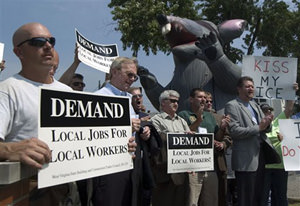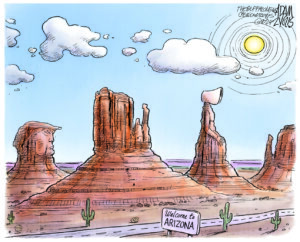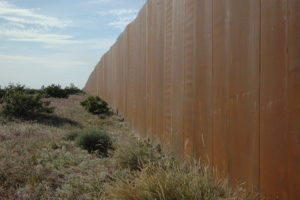Pitting Worker Against Worker
In this May Day special feature, economist Moshe Adler argues that the answer to our immigration, labor and broader economic problems is more immigration and more welfare for all.
Editor’s note: In this May Day special feature, economist Moshe Adler argues that the answer to our immigration, labor and broader economic problems is more immigration and more welfare for all.
All that is wrong with our immigration and labor policies — for the two cannot be separated — is on full display in New York City, where it plays out every day in the city’s small grocery stores. Virtually all of the workers in these stores are undocumented Latin American immigrants. Yet in the adjacent supermarkets, the same jobs are held by American-born workers of all colors. The usual excuse that these are jobs that “Americans won’t do” obviously doesn’t apply. What is the explanation then?
In 2002, then-New York state Attorney General Eliot Spitzer discovered the answer: The small grocery stores pay their workers about half the minimum wage. And what did he do about it? Not much. In exchange for a promise from the grocery store owners not to do it again, he forgave them for their past wage theft. What Spitzer did not do was hire workers to enforce the minimum wage law. (This would have required tax money, and he had his eye on the governorship.) Instead, Spitzer devised a plan by which the merchants would pay for the enforcement themselves. Nothing came of it. Eight years later, the workers in these small grocery stores are still overwhelmingly undocumented immigrants and there is little doubt that their employers continue to steal their wages.
Do illegal immigrants depress the wages of other workers? Of course they do. Supermarket owners will refuse to pay much higher wages than the wages that their competitors pay. Yet the law is not enforced, either against the illegal immigrants, although they swell the ranks of those who seek employment, or against the employers, even though they hire these immigrants at illegally low wages. What is a worker to do?
The academic literature about whether immigration depresses wages is contradictory; some studies find that it does, while others find it does not. But all of these studies suffer from the same methodological problem, which is that interpreting them requires broad assumptions that may not actually hold. These assumptions are significant enough that each camp can continue to dismiss the other. When I present these studies to those of my students who are union construction workers, they laugh them off. They have no use for complex mathematical models when they can drag anybody to construction sites that employ illegal immigrants at low wages — and they know firsthand that this puts direct downward pressure on their own wages. This is what employers tell them. “You are too expensive,” they hear all too often.
Once we admit there is a problem, must we back draconian, Arizona-like measures against illegal immigrants? On the contrary. If illegal immigrants did not need to fear discovery, the small grocers would not be able to pay them illegally low wages. But legalizing immigrants would not end the problem that immigration creates for underpaid workers, because immigration changes the makeup of the work force to the disadvantage of workers with low levels of education in particular.
Immigration does not have any effect on the share of workers with college degrees, regardless of the level of degree. The percentage of workers with a bachelor degree, for instance, is 22 percent among U.S.-born workers, but it is also the same 22 percent in the entire work force, which includes immigrants (both legal and illegal). The percentage of workers without a high school diploma, however, is 6 percent among U.S.-born workers, and 9 percent in the entire work force. This is an increase of 50 percent in the share of workers with low levels of education, an increase that certainly has an effect on wages.
Of course, more workers means greater demand for goods and services and, therefore, more jobs, but here is where balance matters. If the growth in the labor force is weighed against one group, that group will suffer. When the additional workers are paid low wages, the negative effect is larger, because the economic stimulus that poor workers generate is small. In 1950, a worker without a high school degree earned 60 percent of the pay of a worker with a college degree. By 2000, the wage of the worker without a high school degree decreased to just 8 percent. There is no doubt that globalization and the loss of manufacturing jobs had a lot to do with this deterioration, but there is also no doubt that immigration — which is the flip side of globalization — was also a contributing factor.
How can we deal with the imbalance that immigration creates? One way would be to open our immigration doors even wider in order to increase the share of immigrants with high levels of education, and to permit immigrants who are professionals to practice their professions. Many of us have had a taxi driver who was a doctor or an engineer in the old country. With more immigration of the highly educated, the relative position of workers with low levels of education will improve.
Another way would be to enforce the existing labor laws in order to prevent employers from playing immigrants against citizens, and to add government programs that address the problems that immigration creates for underpaid workers, regardless of whether they are immigrants or not. American workers who walk every day into coal mines put the lie to employers’ claim that there are jobs “Americans won’t do.” But workers must be able to support themselves and their families. The minimum wage law should be enforced — and the minimum wage raised — in order to turn all the jobs that currently only destitute immigrants are willing to do into jobs that can support families.But the problems that immigration creates can and should also be addressed directly. An example of how to do this is provided by Israel, because there the problem of immigration is even larger than it is in the United States. In the U.S., 39 percent of the population growth in the years 1990-2004 was due to immigration. In Israel during the same period, 86 percent of the population growth was due to immigration.
Of course, the concern in the U.S. is not about all immigrants, just about illegal immigrants. In Israel, on the other hand, virtually all of the immigrants are legal, as long as they are Jews. While this policy is objectionable in all kinds of ways, it’s nevertheless a useful case study in terms of immigration, since the immigrants to Israel are often poor. (Most of them, 80 percent in the years 1990-2004, came from the former Soviet Union.) So how does Israel deal with this influx of destitute immigrants? By letting them have enough time and enough income to find where they are most needed, they don’t add an imbalance to the work force as a whole.
Jews who immigrate to Israel receive welfare for 18 months, which in Israel is not called welfare but “assured income.” Immigrants also get subsidized mortgages if they wish to buy apartments, or rental subsidies for five years if they wish to rent. As for the makeup of the work force, immigrants get free vocational training and university students get stipends. Finally, free health insurance is available to immigrants for six months. The end result is that immigrants are absorbed with little or no opposition from workers: The work force grows, but so does the demand for labor. Some immigrants become construction workers, for instance, but the demand for housing and therefore for construction workers grows as the new immigrants are housed.
Needless to say, giving these benefits to immigrants only would never be acceptable to workers who are themselves poor. But what if all poor workers got education, training, subsidized housing, and health care? These policies would be costly, but simply ignoring the problem and unleashing the immigrants on the low-wage job market without assuming any responsibility for the consequences is cruel not only to immigrants but also to low-wage, hardworking citizens. The problem of immigration cannot be separated from the problem of labor, and it’s time we dealt with both.
Moshe Adler teaches economics at Columbia University and at the Harry Van Arsdale Center for Labor Studies at Empire State College. He is the author of the book “Economics for the Rest of Us: Debunking the Science That Makes Life Dismal,” recently published by The New Press.
Your support matters…Independent journalism is under threat and overshadowed by heavily funded mainstream media.
You can help level the playing field. Become a member.
Your tax-deductible contribution keeps us digging beneath the headlines to give you thought-provoking, investigative reporting and analysis that unearths what's really happening- without compromise.
Give today to support our courageous, independent journalists.






You need to be a supporter to comment.